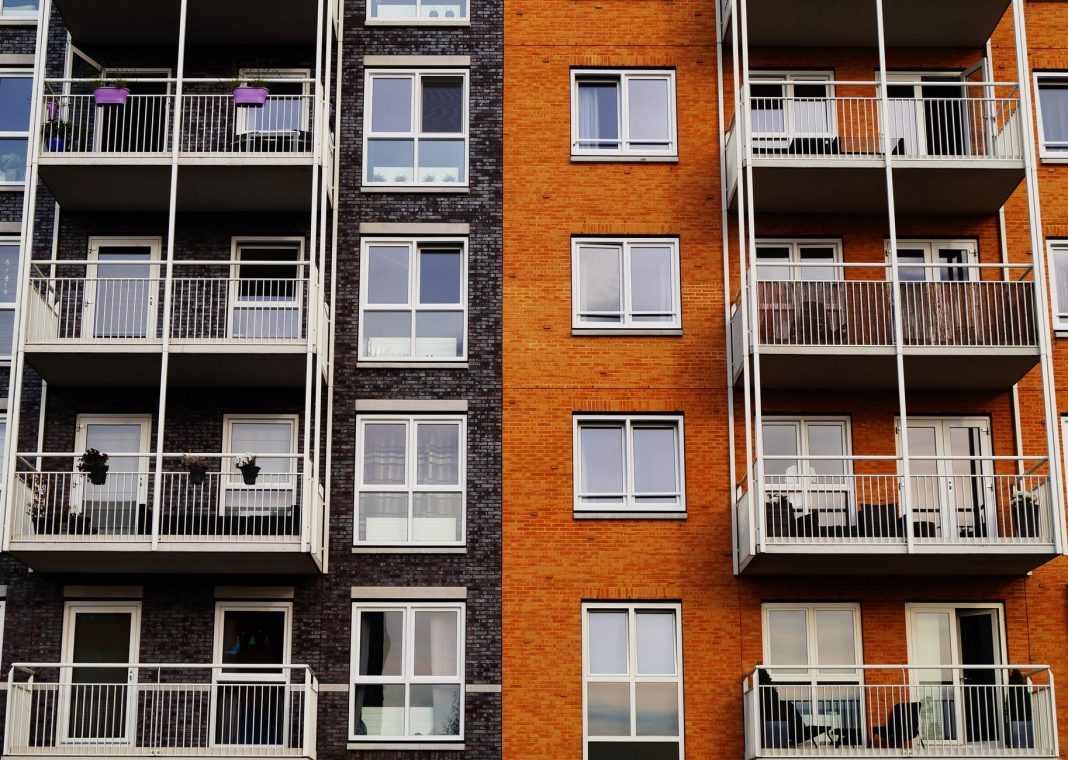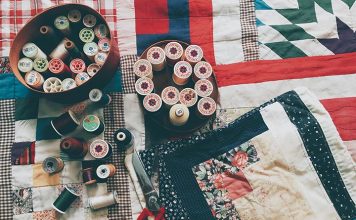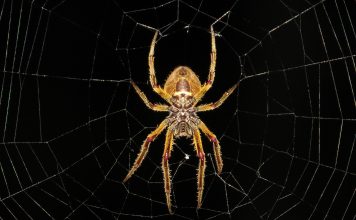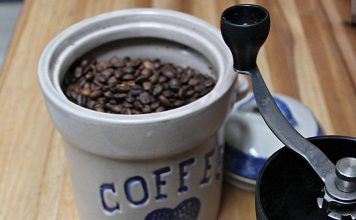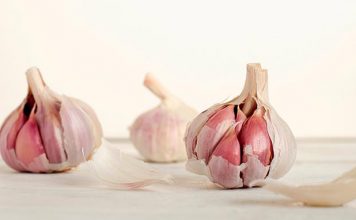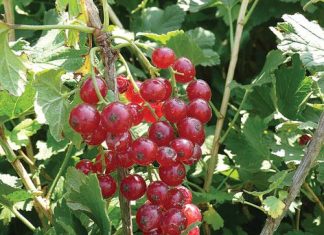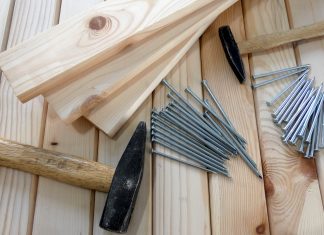| Issue #61 • January/February, 2000 |
You are sitting there in your recliner chair in your small city apartment desperately longing for the day when you can escape to the country and become a homesteader and become more self-sufficient. Well, don’t just sit there. Get a head start. Bloom where you are planted until you can actually make the big move. Don’t waste valuable time in pointless dreaming. Begin making your dreams a reality, now.

White bloom colonnade apple tree.

Stark colonnade apple tree with a petunia.

Stark colonnade apple trees with basket of apples.

Stark maypole flowering crab apple and Stark emerald spire.

Stark Sensation Miniature Peach.
You dream of growing your own fresh, pesticide-free, organic vegetables. So do it. Go dumpster diving and trash mongering and collect all the free containers you can find that will hold soil and that you can poke a few holes into. Wash and disinfect the containers thoroughly. Then get some potting soil suitable for veggies.
Make your own compost to add to your potting soil in a dark corner (or under the sink) by putting shredded newspaper, kitchen wastes (not meat or grease), and coffee grounds in a large container and adding a few earthworms (which you can either buy or collect for free after a rain at the nearby park). Maybe you can get some leaves and grass for your compost bin at the park too. Keep the composting materials moistened.
While you are waiting for your earthworms to make the fertilizer, you can order your seeds. Here, I can give you another shortcut. Since I’m stuck in an in-town situation myself at the moment, I’ve already done the research to find which vegetables are best for small space and container gardening, and where to get them. Here are a few recommendations to get you started. (Keep in mind that this list is by no means all-inclusive. It is only meant as a suggestion.):
-
- Small miracle broccoli, from Park Seed are little beauties that can be planted as close as eight inches apart so you can fit many in a small space. Broccoli is a heavy feeder so compost well and maybe add a sprinkling of blood meal as a side dressing once or twice during the season.
- Early sunglo corn is also from Park Seed. This corn grows on small stalks so they can be planted close together. Enrich your soil with lots of compost and a sprinkling of bone meal and blood meal. You should then be able to plant the seeds about four to six-inches apart each way. Keep the soil moist, but not soaked. The ears will be small but tasty.
- Dynamo mini cabbage, from Johnny’s Selected Seeds can also be planted close together like the broccoli. The same planting instructions apply.
- Kinko mini carrots, from Johnny’s Selected Seeds, grow only four-inches long but you will need a pot at least six-inches or more deep. If you don’t have a pot that deep, Bountiful Gardens offers Parisian rondo heirloom which is a little, round, bite-sized carrot which doesn’t need much space at all. You can plant your carrots two- to three-inches apart each way.
- Superb super bush container tomatoes, from Shepherd’s Garden Seeds, promise to yield abundantly on 2½- to 3-foot space-saving plants. They also boast “firm, juicy fruit with a full tomatoey flavor.”
- Park’s creamy hybrid yellow squash are a straight-necked squash which grows on 18-inch plants. Park Seed also has green magic II zucchini which grows on an 18-inch compact plant as well.
- Sweet pickle peppers, from Park Seed, are the ones to try for an abundance of sweet salad peppers, although most any pepper can be grown in a pot.
- Little gem lettuce, from Park Seed, or little diamond gem lettuce, from The Cook’s Garden, both produce lovely, tiny, sweet, space-saving heads. Each head makes an individual salad.
- Pole (green or yellow) beans of any kind can be grown in a tub. Just make a bean tepee using three or four bamboo poles sunk into the outer edge of the soil in your bean tub. Tie the poles together at the top. Plant four bean seeds around each pole. Emerite, from Cook’s Garden is an “incredibly productive and easy to grow” green, stringless pole bean which should suit your purpose well.
- Pronto baby beets, from The Cook’s Garden is a good beet choice for container growing, because they are small. So, you can fit a lot into a small space. They are also reported to be sugar sweet and are said to retain their tenderness as they mature.
- The Cook’s Garden is also famous for their lettuce mixtures. They offer cutting mix lettuces, fall mix lettuces, and winter mix lettuces. Plus they offer Cook’s tangy mesclun mix and Cook’s mild mesclun mix. Wouldn’t Peter Rabbit be in seventh heaven?
- Most types of radishes and scallions (little green onions) can be grown in pots.
For a container culinary herb garden, Shepherd’s Garden Seeds has a container herb garden seed collection which includes piccolo basil, dukat dill, cilantro, French thyme, Italian parsley, French chives, plus complete seed starting instructions and a brochure on how to care for and harvest your container herbs.
Shepherd’s Seeds also has an herbal tea collection which includes lemon balm, cinnamon basil, chamomile, and anise hyssop. These also come complete with instructions from planting to harvest.
SEED SOURCES
Stark Brothers
P.O. Box 10
Louisiana, MO 63353
Johnny’s Selected Seeds
Foss Hill Road
Albion, ME 04910
Henry Field’s Seed and Nursery Co.
415 North Burnett
Shenandoah, IA 51602
The Cook’s Garden
P.O. Box 535
Londonderry, VT 05148
Bountiful Gardens
Ecology Action
5798 Ridgewood Road
Willits, CA 95490
Park Seed
Geo. W. Park Seed Co. Inc.
1 Parkton Avenue
Greenwood, SC 29647
Shepherd’s Garden Seeds
30 Irene Street
Torrington, CT 06790
So, now that we have your container vegetable garden squared away, let’s talk about your balcony orchard. Orchard? No, I’m not crazy.
You don’t have to live in the country to produce a substantial amount of fruit. If you have a four-foot by six-foot space, you could produce apples, strawberries, cranberries, blueberries and peaches. I’m not kidding. First, however, check with your landlord to find out how much extra weight your balcony can hold before you purchase any trees. With that information in hand, now you can choose your combination of trees:
- Stark Brothers Nursery offers colonnade apple trees which can be planted in containers as small as 17 inches. The trees grow eight-feet tall and two-feet wide and come in five varieties. When mature, they produce an abundance of full-sized, deliciously flavored apples. But, you will need to plant at least two for proper pollination.
- Henry Field’s Seed and Nursery will sell you a strawberry tower which takes up only two feet by two feet of space, is on casters for easy moving, and comes in two heights. The two-foot version holds 45 strawberry plants and the four-foot version holds 90. At a recommended 25 plants per person in the household you can do some serious strawberry picking here. By the way, I hear that Ozark beauty strawberries grow well in towers.
- Henry Field’s also offers a new cascading cranberry which can be grown in hanging baskets. They like acidic soil and don’t even mind shade.
- Dwarf top hat blueberry plants, again from Henry Field’s, grow only two-feet tall, but produce full-sized berries. They are even self-pollinating.
- Finally, Stark Brothers has developed the cutest little peach tree called Stark sensation. When it matures, it will produce full-sized fruit but is small enough to be grown in an 18- to 24-inch container. And, if you have a wee bit of extra space, they will sell you a mini apricot and a mini-nectarine tree as well.
So, with your vegetables, herbs, and fruits established in pots, your apartment gardens and orchard are all transportable. That means you can take them with you and continue to enjoy a measure of healthy food until you finally make that move to the country and get your full-sized garden and orchard established. Truly the best of both worlds.


